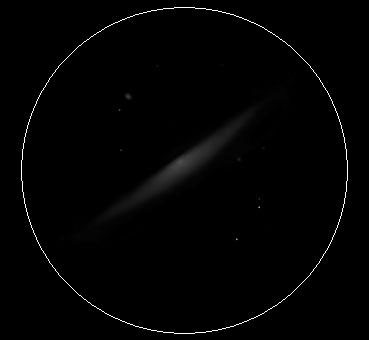
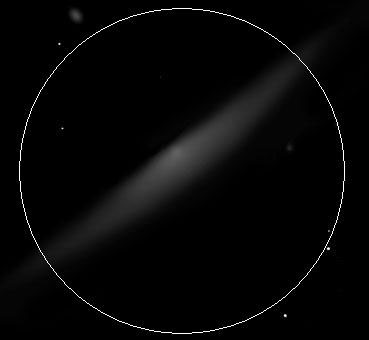

On this page the author is attempting a careful electronic sketch simulation of what he saw while on the Antiparos island, with his Equipment.
The author is more concerned with giving the sketches a realistic appearance, i.e. for them to represent well what an observer sees through the above equipment[1].
All the sketches were digitally processed using Photoshop from observations made on average 6.7+ skies. Contrast and brightness have been changed sometimes globally, sometimes locally and extended star images have been anti-aliased, where applicable. The author is paying more attention to extended objects and not star images[2], aiming at a realistic simulation.
Calculations for the digital processing assume correct fields of vision of all three instruments and changes in brightness according to what the author saw, in most cases. Occasionally, field edges have been cropped, to save space and time. The processing has been done on a Presario 2100 laptop with its screen at full brightness.
All pictures below:
M31-M32-M110 (Andromeda Galaxy and satellites) in Andromeda
 |
 |
 |
M51 (Whirlpool Galaxy) in Canes Venatici
 |
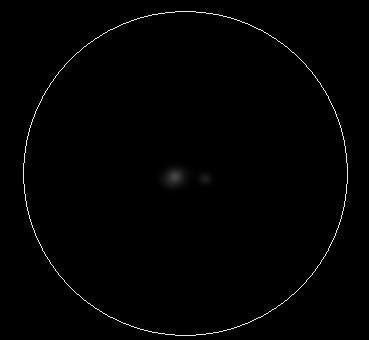 |
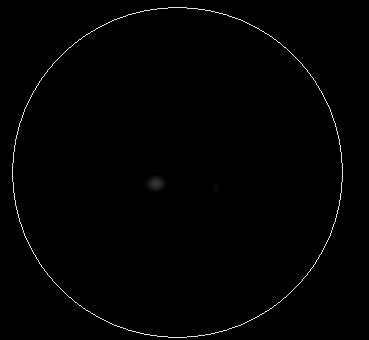 |
M8 (Lagoon Nebula) in Sagittarius
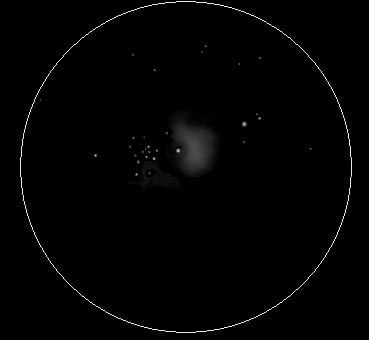 |
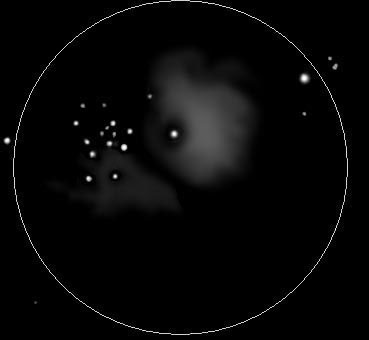 |
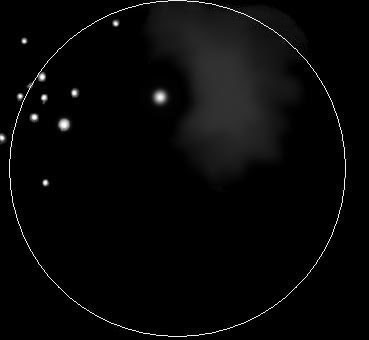 |
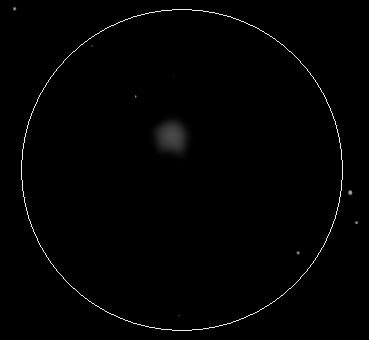 |
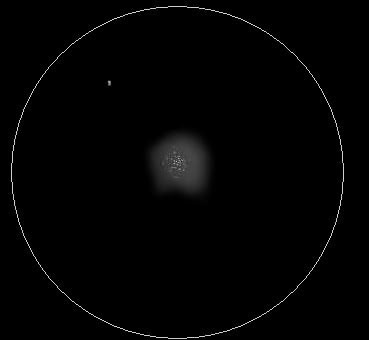 |
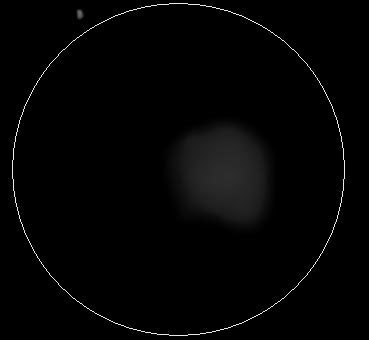 |
M57 (Ring Nebula) in Lyra (Tasco@80x)
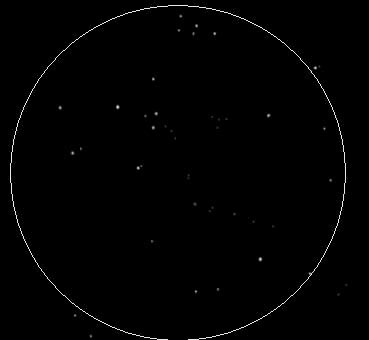 |
 |
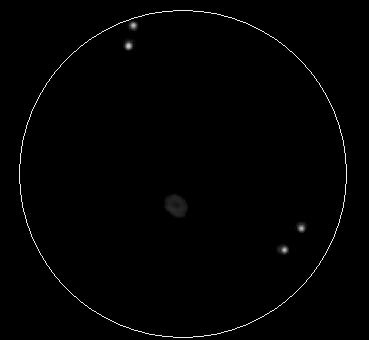 |
M33 (Triangulum Galaxy) in Triangulum
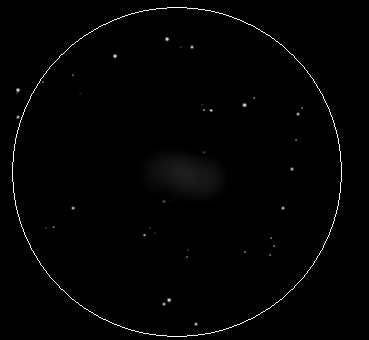 |
 |
 |
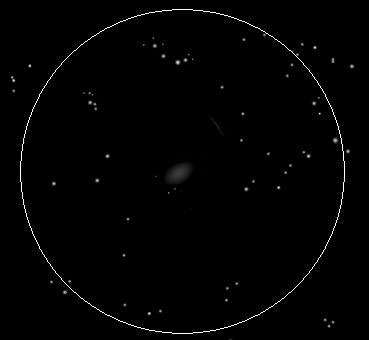 |
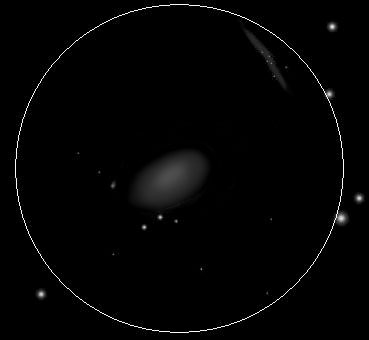 |
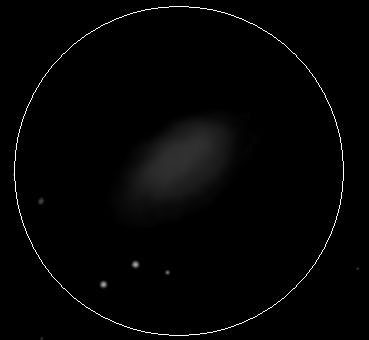 |
 |
 |
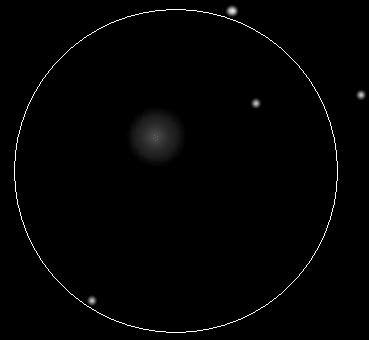 |
M27 (Dumbbell Nebula) in Vulpecula
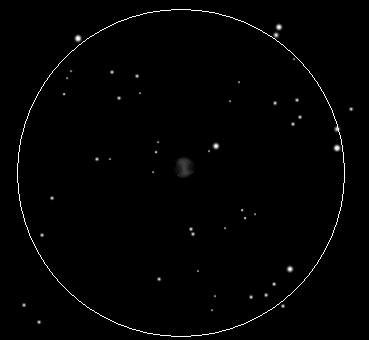 |
 |
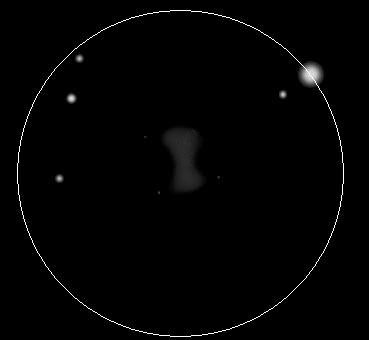 |
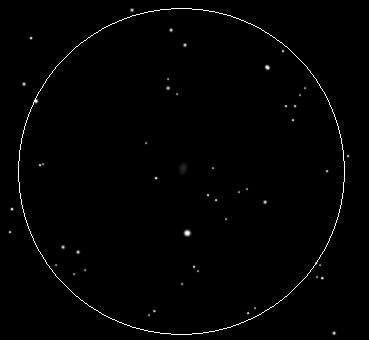 |
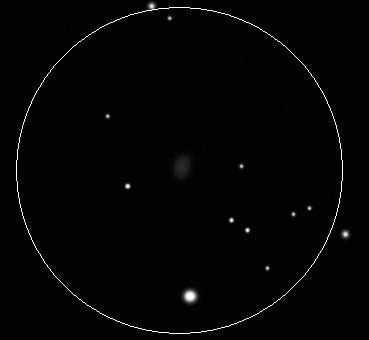 |
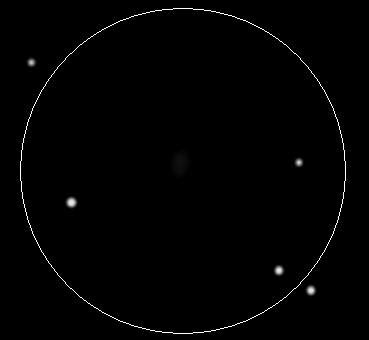 |
NGC 7293 (Helix Nebula) in Aquarius
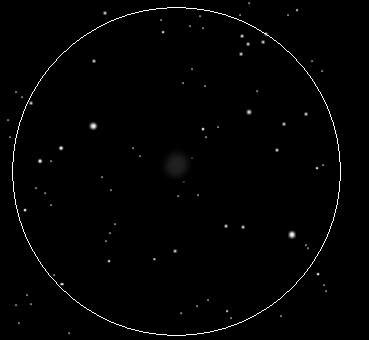 |
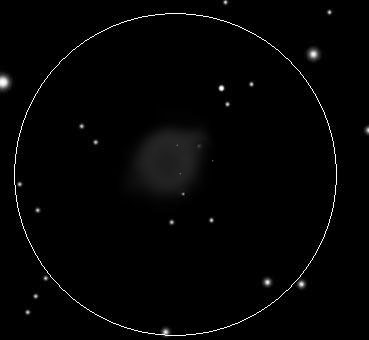 |
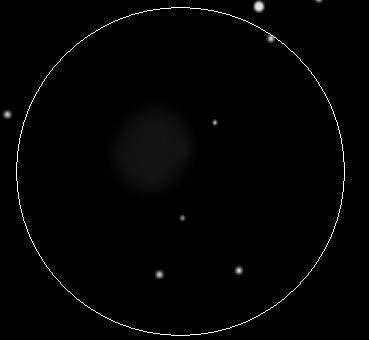 |
M11 (Wild Ducks Cluster) in Scutum
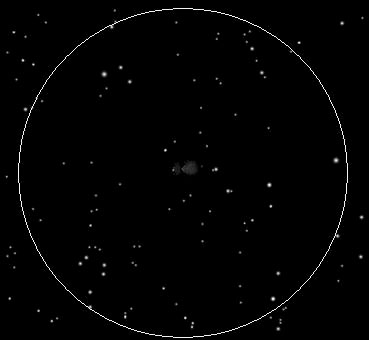 |
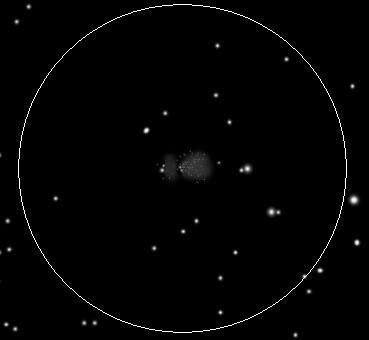 |
 |
Some Useful Theoretics[3]
| Magnification: | Mx=Dfl/EPfl |
| Exit pupil: | Dep=Ds/Mx[5] |
| Actual exit pupil: | Dep*=min{EYEexitp, Dep} |
| Transmission factor: | θ~ 64% for refractors, 67% for reflectors[4] |
| Raw light grasp brightness: | G=θ*Ds2/Dep2 |
| Relative brightness: | RB = θ*Ds2/(Dep*)2*Mx2 |
| Telescopic brightness: | Btel= θ*Ds2/(Dep*)2/Mx2 |
| Magnitudes per aperture inch (γ): | γ*Ds=Mx |
| Relative telescopic brightness: | RBtel=θ/(γ*Dep*)2 |
| Point source resolution limit (Reyleigh): | Rθ=1.22*λ/Ds |
Using the above, we can generate a table which compares between different Ds' and Mx's with Maple code:
Dobj := [25.4, 76.2, 88.9, 101.6, 120.7, 152.4, 203.2, 254.0, 304.8];#list of
Ds'
M := [6, 8, 10, 20, 30, 40, 50, 60, 70, 80, 90, 100, 110, 120, 130, 140, 150];#list of
Mx's
ps := "%";
for r to nops(M) do
for c to nops(Dobj) do
printf("%6.2f%1s", 100*RBtel(1, 7, Dobj[c], M[r])*Dexitp(Dobj[c], M[r])
/(RBtel(1, 7, Dobj[nops(Dobj)], M[1])*Dexitp(Dobj[nops(Dobj)], M[r])), ps)
end do;
printf("\n")
end do;
Relative Telescopic Brightness (constant θ for all)
| Dobj (in)[6] | 1 | 3 | 3.5 | 4 | 4.75 | 6 | 8 | 10 | 12 |
| Dobj (mm) | 25.4 | 76.2 | 88.9 | 101.6 | 120.7 | 152.4 | 203.2 | 254.0 | 304.8 |
| 6x | 0.06% | 1.56% | 2.48% | 3.70% | 6.20% | 12.50% | 29.63% | 57.87% | 100% |
| 8x | 0.03% | 0.88% | 1.40% | 2.08% | 3.49% | 7.03% | 16.67% | 32.55% | 56.25% |
| 10x | 0.02% | 0.56% | 0.89% | 1.33% | 2.23% | 4.50% | 10.67% | 20.83% | 36.00% |
| 20x | 0.01% | 0.14% | 0.22% | 0.33% | 0.56% | 1.13% | 2.67% | 5.21% | 9.00% |
| 30x | 0.00% | 0.06% | 0.10% | 0.15% | 0.25% | 0.50% | 1.19% | 2.31% | 4.00% |
| 40x | 0.00% | 0.04% | 0.06% | 0.08% | 0.14% | 0.28% | 0.67% | 1.30% | 2.25% |
| 50x | 0.00% | 0.02% | 0.04% | 0.05% | 0.09% | 0.18% | 0.43% | 0.83% | 1.44% |
| 60x | 0.00% | 0.02% | 0.02% | 0.04% | 0.06% | 0.13% | 0.3% | 0.58% | 1.00% |
| 70x | 0.00% | 0.01% | 0.02% | 0.03% | 0.05% | 0.09% | 0.22% | 0.43% | 0.73% |
| 80x | 0.00% | 0.01% | 0.01% | 0.02% | 0.03% | 0.07% | 0.17% | 0.33% | 0.56% |
| 90x | 0.00% | 0.01% | 0.01% | 0.02% | 0.03% | 0.06% | 0.13% | 0.26% | 0.44% |
| 100x | 0.00% | 0.01% | 0.01% | 0.01% | 0.02% | 0.05% | 0.11% | 0.21% | 0.36% |
| 110x | 0.00% | 0.00% | 0.01% | 0.02% | 0.02% | 0.04% | 0.09% | 0.17% | 0.30% |
| 120x | 0.00% | 0.00% | 0.01% | 0.01% | 0.02% | 0.03% | 0.07% | 0.14% | 0.25% |
| 130x | 0.00% | 0.00% | 0.01% | 0.01% | 0.01% | 0.03% | 0.06% | 0.12% | 0.21% |
| 140x | 0.00% | 0.00% | 0.00% | 0.01% | 0.01% | 0.02% | 0.05% | 0.11% | 0.18% |
| 150x | 0.00% | 0.00% | 0.00% | 0.01% | 0.01% | 0.02% | 0.05% | 0.09% | 0.16% |
Perceived Relative Telescopic Brightness (constant θ for all)
The eye's light response stimulus curve is logarithmic[3]. Adjusting the above to an arbitrary brightness scale from 0 to 10 (brightest: - 12"@6x), we get[6]:
| Dobj (in)[6] | 1 | 3 | 3.5 | 4 | 4.75 | 6 | 8 | 10 | 12 |
| Dobj (mm) | 25.4 | 76.2 | 88.9 | 101.6 | 120.7 | 152.4 | 203.2 | 254.0 | 304.8 |
| 6x | 6.76 | 8.19 | 8.39 | 8.57 | 8.79 | 9.10 | 9.47 | 9.76 | 10.00 |
| 8x | 6.51 | 7.94 | 8.14 | 8.32 | 8.54 | 8.85 | 9.22 | 9.51 | 9.75 |
| 10x | 6.32 | 7.75 | 7.95 | 8.12 | 8.35 | 8.65 | 9.03 | 9.32 | 9.56 |
| 20x | 5.72 | 7.15 | 7.35 | 7.52 | 7.75 | 8.05 | 8.43 | 8.72 | 8.95 |
| 30x | 5.36* | 6.80 | 7.00 | 7.17 | 7.40 | 7.70 | 8.07 | 8.36 | 8.60 |
| 40x | 5.11 | 6.55 | 6.75 | 6.92 | 7.15 | 7.45 | 7.82 | 8.11 | 8.35 |
| 50x | 4.92 | 6.35 | 6.55 | 6.73 | 6.95 | 7.26 | 7.63 | 7.92 | 8.16 |
| 60x | 4.76 | 6.19 | 6.39 | 6.57 | 6.79 | 7.10 | 7.47 | 7.76 | 8.00 |
| 70x | 4.63 | 6.06 | 6.26 | 6.43 | 6.66 | 6.96 | 7.34 | 7.63 | 7.87 |
| 80x | 4.51 | 5.94 | 6.14 | 6.32 | 6.54 | 6.85 | 7.22 | 7.51 | 7.75 |
| 90x | 4.41 | 5.84* | 6.04 | 6.22 | 6.44 | 6.74 | 7.12 | 7.41 | 7.65 |
| 100x | 4.32 | 5.75 | 5.95 | 6.12 | 6.35 | 6.65 | 7.03 | 7.32 | 7.56 |
| 110x | 4.24 | 5.67 | 5.87* | 6.04 | 6.27 | 6.57 | 6.95 | 7.24 | 7.47 |
| 120x | 4.16 | 5.59 | 5.79 | 5.97 | 6.19 | 6.49 | 6.87 | 7.16 | 7.40 |
| 130x | 4.09 | 5.52 | 5.72 | 5.90* | 6.12 | 6.43 | 6.80 | 7.09 | 7.33 |
| 140x | 4.03 | 5.46 | 5.66 | 5.83 | 6.06 | 6.36 | 6.74 | 7.03 | 7.26 |
| 150x | 3.97 | 5.40 | 5.60 | 5.77 | 6.00* | 6.30 | 6.68 | 6.97 | 7.20 |
Locate your scope on the table above, using your Dobj and required nagnification Mx and compare between the values on the corresponding entries. For example, for the three instruments on this page: Tasco at Mx=60mm@56x=700/12.5~6.1, Chinon 11x80~7.7 (Because of measured Vignette its objective is closer to 76mm really) and Apogee 20x100~7.5 (without having yet measured Vignette). In practical terms the previous mean that on the same DSO extended target at the aforementioned magnifications, the Chinon's image would be about 7.7-6.1=1.6 unit times brighter than that of the Tasco and about 7.7-7.5=0.2 unit times brighter than that of the Apogee, with the latter being 7.5-6.1=1.4 unit times brighter than the Tasco's, on an arbitrary brightness unit scale from 1 to 10, with 10 being the reference perceived full brightness of a 12"@6x of the same DSO[7].